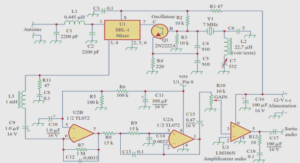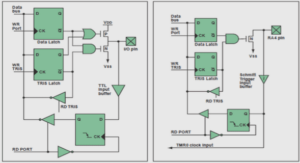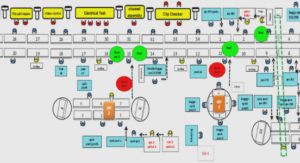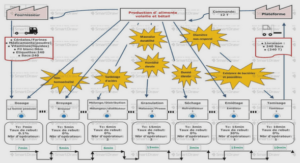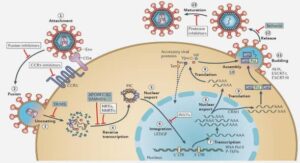Proton acceleration in the high contrast regime
The experimental campaign took place in the Salle Jaune between January 2007 and April 2008. Despite its long duration, it brought to roughly two months of laser time. The beginning of the experiment coincided with the re-opening of the laser installation after important upgrades of the system, notably the installation of the XPW stage and related devices, with the consequent rebuilt of the entire front-end. The third amplification stage (4-pass, ×20) passed from cryogenic to water-chilled, which re-opened the problem of thermal lensing, needing static (refractive) correction. As a consequence the phase front worsens and day to day variation of the beam divergence is observed; moreover the refractive correction is calculated for a fixed thermal gradient in the crystal, hence for a precise flux of laser pumps. The user is not anymore free to continuously change the laser output energy. This experimental campaign also aims to test, for the first time, the new proton diagnostic back-end, which includes the use of image plates to monitor the beam direction and divergence and the MCP-based Thomson Parabola setup (6.2.2). In this chapter I focus on the results that are obtained with the setup described in Ch.6. The first part is dedicated to the results that are published in literature and that represent the present horizon of this topic. A second part is dedicated to the description of the experimental procedure that have been defined during the experiment. Finally the results are extensively presented and discussed.
Previous Works
The laser ion acceleration was first obtained by Gitomer et al.[36] in 1986, after the growing interest in late seventies on the presence of ion signals of different species coming from laser produced plasmas. Since then, a number of experiments have been performed, to understand the correlation between the characteristics of the accelerated charge (cutoff energy, relative importance of the different species, direction of emission and beam divergence) and the target (material, thickness) and laser parameters (energy, shape, peak intensity). The maximum energy with a long pulse, high energy laser1 was obtained by Snavely et al. [93, 41] in 2000 on a 125µm thick aluminum target, with a proton energy cutoff of EMAX = 58MeV . In the short pulse, low energy limit, the highest energy ever achieved is EMAX = 12MeV on the Salle Jaune laser system by S. Fritzler in 2003 [28] on a 10µm thick aluminum foil. Two other independent experiments, [79] for τL = 400fs, I0 = 6.01018W/cm2 and for τL = 450fs, I0 = 5.51018W/cm2 report proton energies above 10MeV The energy spectrum is a Maxwellian-like distribution with a defined cutoff. The divergence of the proton beam changes depending to the proton energy, and the higher the energy, the lower the divergence. In [15] a divergence of 10◦ (FWHM) for 10MeV protons is measured. Origin of the proton signal As discussed in 3.4, the expansion of a plasma where a difference in temperature exists between the electron and the ion population, produces the strong acceleration of the ions in the peripheral region. The origin of a proton signal among the different ion species is found in the contamination of the target’s surfaces by hydrogenated compound (H2O, organic molecules). This is in accord with the presence of a proton signal independently of the target material. The effect of the surface contamination has been confirmed by experiments where contaminants have been removed by target heating and laser ablation : in these cases higher ion energies are observed, which confirms the electrostatic nature of the acceleration process. Mechanisms of acceleration The protons are extracted and accelerated from the two exposed surfaces, the irradiated (front) and the non-irradiated (rear). The scientific community has been discussing long time about which of the two effects was producing the most effective acceleration. Some numerical studies 1 I0 = 3 × 1020W/cm2 with EL = 48J. 104 7.1. Previous Works [83] showed that the most energetic and least divergent beam comes actually from the rear surface, while the front accelerated have bigger spread and lower cutoff energy. An extensive study on the correlation between the front surface accelerated ions and laser parameters has been performed by Habara et al. [40, 39] by using carbon targets that were deuterated only on one of the surfaces. Fuchs experimentally showed that for a 30J, 350fs laser interacting with a 20µm thick aluminum target, the most energetic protons are accelerated from the non-illuminated surface. Mackinnon used a smaller intensity laser pulse to create a plasma with a gradient scale length of 100µm on the rear surface of a 25µm thick aluminum target. He observed that in conjunction with this plasma gradient, the proton energy cutoff was lowered from 21MeV to < 5MeV . In [49] is underlined that, being the front face accelerating mechanism independent from the target thickness, the front accelerated protons would take over in the spectrum when TNSA is made ineffective by target destruction. This argument is more deeply investigated in section 3.3. Effect of laser parameters The laser parameters influence the acceleration mechanisms and the proton cut-off energy on a two-fold basis: (i) depending on the parameters themselves, like intensity and energy, and (ii) in conjunction with the some of the target parameters. As a general rule, for a given intensity (power over surface), more energetic protons are produced by the most energetic pulse. Different situations need however to be analyzed specifically. For the front surface acceleration (3.4.1), the scaling law (3.26) shows a linear dependence between the cutoff energy and the normalized amplitude parameter a ∝ √ I0 ∝ p EL/τ . For the rear surface accelerated ions, no precise scaling law exist. Limiting ourselves to the dependence on the laser intensity, a simple rule can be obtained from the isothermal model (3.34)2 . Neglecting for the moment the term in log ()., the energy is proportional to kBTe. From an extremely simplified calculation, one can write the electron temperature from kBTe = (γ − 1) m0c 2
Experimental procedure
The thin aluminum foils are positioned between two nickel holders on a 5-axis (3 spatial, 2 tilts) mount. The initial focus position is set in a range of ∼ 200µm by simply looking at the speckle field that is produced by the helium-neon laser (collinear to the pump beam path) on the metallic target. This position is set as reference on the highmagnification focus reference (Fig.6.6-6). The two tilt axis are regulated so that moving 4This law apparently contrasts with the experimental results that are presented in Ch.5 for the reflectometry experiment. This discrepancy is discussed in 7.4.1. 108 7.2. Experimental procedure the target holder in a range of 3 × 3 shot positions5 doesn’t change the relative focus reference by more than 50µm6 . This ensures a maximum tilt of ∼ 0.9 ◦ with respect to the pinhole-TP-MCP axis. The chamber is pumped down to a vacuum better than 10−3 and MCP is activated. Error Estimation The principle source of uncertainty in the experimental procedure is represented by the laser system itself. I believe that the fluctuation of its parameters can absorb all other errors on motors and image analysis. For this reason, in the rest of the chapter, the experimental the experimental proton energies are an average of many (at least three) shots of the same experimental configuration; the associated error bars are calculated from the width of distribution of the acquired data.
Validation of experimental parameters
Target focusing
The correct position in focus is searched from the direct experimental feedback of the proton signal: targets are moved around the first reference by steps of 25µm (which is above the resolution limit of the focus reference and about the Rayleigh depth of the parabola) and shot at least twice. According to (2.8) the peak intensity is changed which affects the expected ion energy cutoff. In the normal case, a single peak is found, well reproducing the change in intensity (Fig.7.4). The focus position is normally found no further than 150µm away from the helium-neon alignment and normal laser conditions give fluctuations lower than 10% in proton energy. In the waist, our laser and optics parameters produce a peak intensity in the order of ∼ 5 × 1019W/cm2 . The procedure shows two kinds of deviations from the standard behaviour: (i) a twopeaks structured plot and (ii) a flat region well wider than the expected Rayleigh range. This simple fact underlines the extreme improvement that a real time diagnostic system represents for the laser ion acceleration experiments. The two effects are now briefly discussed.
MCP Calibration and Alignment
The MCP-based diagnostic system has to be validated from the point of view of (i) the direction of the measure, i.e. the solid angle where the incoming charge is collected, and (ii) the absolute measure of the proton energy.
Proton Acceleration with Enhanced Contrast Laser
In the realized setup, the MCP entrance pinhole sets a solid angle of beam integration of ∼ 5 × 10−8 sr that corresponds to an horizontal sweep angle of ∼ 0.25mrad. This axis is fixed on the chamber axis. As previously discussed in section 7.2, the targets are aligned to a tilt better than ∼ 0.9 ◦ to the chamber axis. The typical half divergence of the more energetic part of the ion beam is in the order of 7◦ to 10◦ [15] which makes our alignment good enough not to miss the main beam. Nevertheless the possibility of a misalignment of the ion beam due to pre-pulse effect have to be considered, to ensure the self-consistency of the acquired data. In [56, 88, 57], the deformation of the rear target surface induced by the emerging shock wave is considered responsible of a lateral drift of the most energetic part of the ion beam, towards the laser axis. Given ∆θP the half divergence of the highest energy part of the beam and θP the described deviation on the horizontal plane, in the typical case of θP = 5◦ and ∆θP = 10◦ 7 , the remaining uncertainty due to target tilt must be lower than ∼ 5 ◦ . As a general precaution, whenever contrast effect like the one in Fig.7.5 are observed on the thinnest target, any other data from thicker foils is discarded. Proton energy calibration The maximum proton energy is calculated from the distance between the cutoff of the proton track and the measured zero point. The distance is converted in microns and the calibration curve for the dispersion in the magnetic field (6.2.2) interpolated to find the corresponding energy. To validate the energies that are obtained in this way (so to validate the entire process in detection, measure and calibration of the Thomson Parabola), a certain number of shots has been repeated on MCP and on multiple CR39 foils covered by filters of appropriate stopping power.

